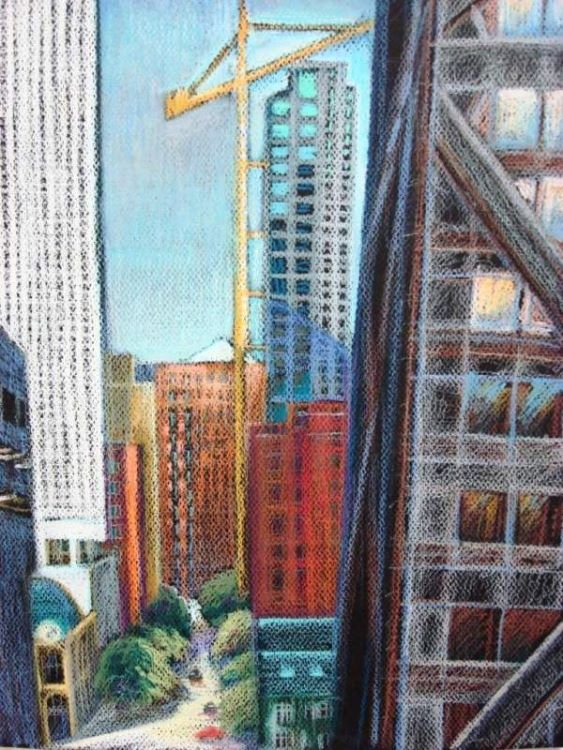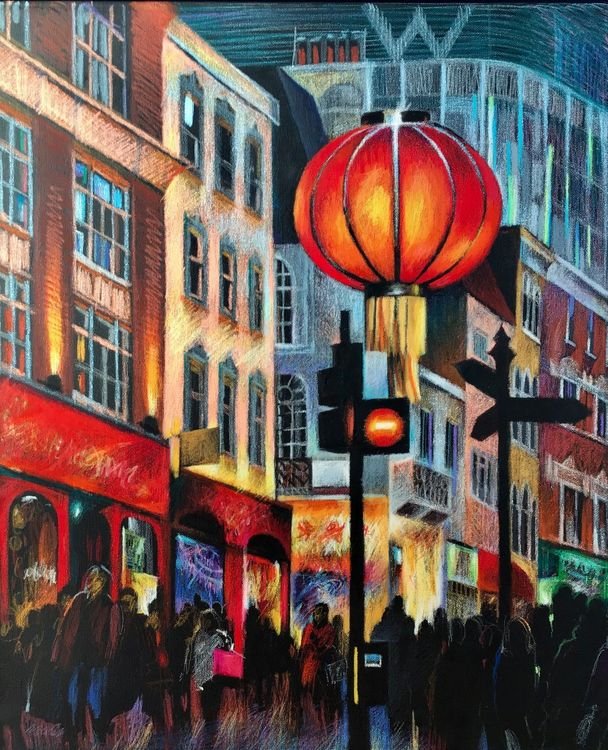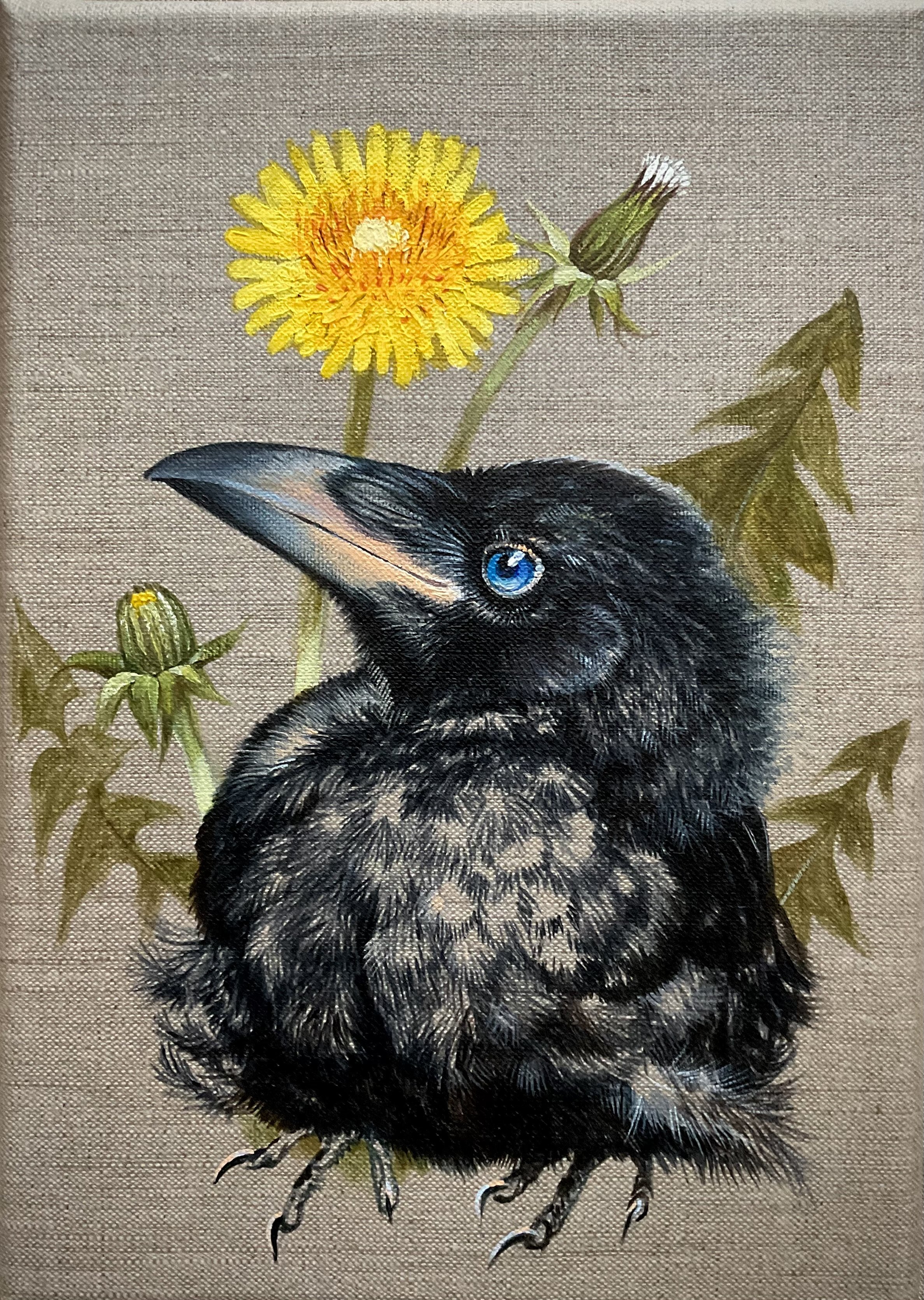ARTIST INTERVIEW: Mary Swift
Mary Swift
Please introduce yourself. What sparked your interest in becoming an artist?
Hi, I’m Mary, a raven artist from London. I’m the third generation of artists in my family, so that made it natural to start painting the same time as walking! I was continuously inspired, prompted and challenged by my surroundings, and to express myself through art from very early childhood.
Everyone around me was doing something creative - painting gigantic murals or miniatures, decorating interiors or clothes, sketching from life everywhere, teaching us kids to notice and admire the nature around us, but most of all I was fascinated and attracted by the beautiful illustrated books we had at home.
All of this made my path pretty much set before me from the start, as far as education, career and meaning of what I do, but it didn’t make it any less of a challenging adventure to follow this path keenly until present day. If anything, this defined start made the way more challenging for me, because I had in view the higher, uncompromising standards to confirm to. In short, for me, being an artist was never a choice, it was simply my life all along.
Why are you so fascinated by birds? What originally drew you to this subject?
Birds are like little people. If animals can copy some human-like qualities, they demonstrate behavioural patterns inside their species, when as birds are personally differing from each other inside one kind, just as human. They seem to be like clean different kind of creatures, like little nature spirits, sprites or folklore characters, gnomes if you like. Birds have enormous personalities, especially considering how small they are.
The story started on my plein-air in Kensington Gardens when we shared a big bag of cashew nuts I had, with the random crow with his sparkling eye on my cashews, in a way of casual picnic, and I felt a connection, I saw the intelligence and personality in this caning little creature.
Step two was a wonderful book I got for Christmas, called The Ravenmaster, written by Christopher Skaife, the yeomen warden of the Tower of London, about its legendary residents; the ravens. I was greatly moved by the book and started to come to the Tower to sketch and draw from life these amazing creatures, I learned to know them by their names and tell one from another at a glance, learned a lot about their behaviour and personalities.
After that, I got many friends and acquaintances among my own local crow and magpie families. We have long lasting relationships and stories with my neighbouring corvid families.
Alike many people, I always knew in theory that corvids are birds of an outstanding intelligence, but it takes a personal relationship to fully appreciate their mind and soul. This was how crows stepped into my canvas and made themselves at home there.
What have you been able to gain from your travelling experiences? How have your visits to numerous cities been influential to your work?
Cities are like living people, rather than places. It is exciting to meet them, you get inspired by the relationship, you miss them, you fall in love… this living story is what makes me open my sketchbook wherever I go.
New York makes me to splash and throw broad acrylic strokes on the big format, resonating with its powerful big energy.
Chicago made me want to employ a new technique. The city was completely destroyed by the fire and fully rebuilt from the ground, this prompted me to draw it on the toned paper sheets using wax pastels, because what you see there, is clear colours and clear straight architecture lines of the freshly outlined against the big blue skie. And at night it’s a colourful sea of pulsating lights against the velvet black or brown, this is where all my pastels on the black canvas came to be.
Paris always tempting you to the free flowing, light watercolours made quickly in the park or a café.
Florida taught me new colours and an unbelievable light and transparency, not to mention the whole gang of the new bird characters I met there and now pelicans, ospreys and cardinals that are included in my painting folklore.
Prague makes you to tell a story with the ink and quill in a sketchbook, and London is very intimate, cozy, monochrome almost, with the red accents of the buses, phone booths or post boxes. London is all in the details.
In painting, any new work you make is adding to your creative tools. Every new experience put through your eye and hand, enhances your abilities, you see more, feel deeper and express what you want with more ease and freedom at every step.
Visiting and reflecting in work all these cities I have to say, gave me a pair of big shining wings to soar in all my creative processes, not even related to the landscapes as such.
You have illustrated two children’s books. What was your creative process? Why did you choose to illustrate a children’s book?
I always wanted to be an illustrator. Beautiful illustrated books were the reason for me becoming an artist. But entering the University I decided to go interior design, to have advantage of monumental decorative approach to complement my natural love for the small details and literal storytelling.
So now, illustrating children’s books is like coming home, coming to myself.
When I read a story or a poem, I see pictures in my head right away, I just need to pick up a pencil and make a lay out of the major scenes in scribbled miniatures, like a comic book, and after I just go scene by scene, always quoting the book by heart to myself, trying to say with facial expressions, gestures and little details everything that’s going on and everything that was meant but not said by the author.
I’m presently finishing another book, The London Starling, it is a book we are creating together with London author and publisher of Magmay Books, Wendy Gallagher. I couldn’t dream of a better story or a better author to work with! The book is about birds that actually live in London. It’s a beautiful story of a little starling called Star, based on the real facts and a little fantasy about the wildlife in this big city.
Tell me about your most recent work and the process for creating it. What is the piece about?
It’s a fluffy crow bringing a little gift. “For you” it’s a very small painting, 20x20 cm canvas. I intended it to be just a birthday gift for my dear crow friend, not for sale, but as often happens, the piece I do with love for someone in particular, comes out the most appealing and I made on request a freehand copy of it and even commissioned the series of it, same size, same spirit and motive, but different crow characters on each canvas.
I took the pictures of crows on the roof that my friend in Vienna makes as an inspiration, and made them in the enhanced colours of the bright morning light in the city, as I remember them, and enriched the personality of the bird, working on its face and posture. I also added the playful element into the composition – a tiny gift, wrapped pink box with the bright blue bow and crow stepping on the tail of it, to unwrap for you, or just being clumsy, or not letting you to take the present and open it… you never know with these crows.
You use a variety of mediums throughout your work, which is your favourite to use and why?
Different mediums are like different outfits we wear – one is perfect for workouts, another is your favourite for the night out, the third is the most comfortable for work days, it is hard to compare them, everyone is serving its best for its task. It is the same for me with mediums: watercolour is wonderful for conveying the delicacy, richness and transparency of the flowers. Acrylic is perfect for the clear colours and fine details of my bird series, where the details of face and feathers are important to create the personality and little meaningful details to tell the story.I love the pastels, especially on toned paper, as means of quickly capturing the mood and feel of the landscape or cityscape from life, and it’s very convenient to carry these materials for the field work. But of course, oil on canvas is the king, combining all the fine qualities of all painting techniques, it can be light, it can be heavy, precise or ambiguous, the only thing is that it requires more time to work with and makes the works more expensive, that’s why it is not always my first choice in this dynamic art life of today, although it is my love forever.
Out of all your work, which piece are you most proud of?
Snapshot Crows logo design! It was an unexpected and exciting commission that turned into the great friendship.
I loved designing and drawing out this crow themed logotype for the famous Viennese crowtographer, crow-fluencer and corvid populariser, and I’m sincerely proud of how it came out, and of the fact that now it shines on every product of Snapshot Crows brand and every publication!
There was a lot of creative and technical graphic work that was both challenging and satisfying for me, professionally and personally.
What has been your greatest achievement so far as an artist? Have you endured any challenges?
Painting for the Queen, running my art business, and every sale I make!
Every sale is the greatest achievement for the artist, and not even because it’s my livelihood. Sale of artwork means that what you’ve created, resonated so much with some other soul, that the person is willing to share its hard-earned means of living with you, to have your work in his life. This fact is indeed giving meaning to what you do.
I painted ravens of the Tower, guardians of the Kingdom, for Her Majesty’s birthday, and I’m very proud of this painting, because the honour and feeling of one’s own inadequacy were overwhelming, but I did! And I was happy with the work I made and with gratifying letter from her Majesty, which I keep framed, of course, on my wall!
Running one’s own small business is a challenge enough, but it is even more so for practicing full time artist. Because art you do is something very personal, even intimate. You expose your soul in creating, you pour It out for everyone to see and to judge. And for business to be successful, you shouldn’t be personal in managing it. To balance between your own creative world and the big world living by the rule of commerce, marketing, competition, and not to lose sight of the right values, not to lose heart at failures and rejections, this is a real challenge for the artist.
On one hand, searching for the best way to express what have inspired you, practicing your eye and hand all the time, to be in the perfect shape to paint whatever you see in your mind, what image or idea possesses your heart. On the other, it’s promoting what you do, putting it out there on web, on social media, on the gallery walls, connecting to people, communicating with clients, managing accounting, taxes, logistic, watching every delivery, doing all the paperwork, merchandise, bookings and applications – all this takes a lot of energy and time, and becomes personal, though it should not, because it’s all about your art.
In painting there’s no comfort zone, every new work is a challenge of its own, if you are putting your heart in it, not merely producing images as the AI does. This is why, with all the inner creative challenges like selling your art successfully, is the biggest achievement for the artist, at least, the greatest for me.
Why do you think art is important in society?
I see art as the way of communication between people. It is like to say: ‘Oh, look how beautiful it is!’ or, ‘Look what I found! Isn’t it wonderful?’ or, ‘That’s what I think about it, what do you think?’.
How important is communication for society?
Art broadens the horizon, it lifts you up to the higher view point, it enables one to see the reality through someone else’s eyes, in a different perspective, enables one deep into the energy different from one’s own. This is how I see it, and for that reason I believe that the artist is responsible before people, in what he creates. I personally don’t approve of art becoming some or other ideological platform, I believe that we as artists, are called to bring only timeless good things – joy, beauty and goodness in life of people around us. Art is a jest of wonder, and when you are in awe of something, you cannot be angry, or lazy or depressed at the same moment, you will be glad, grateful, lifted up, and want to pass goodness onto someone around. This is how important the good art is!













